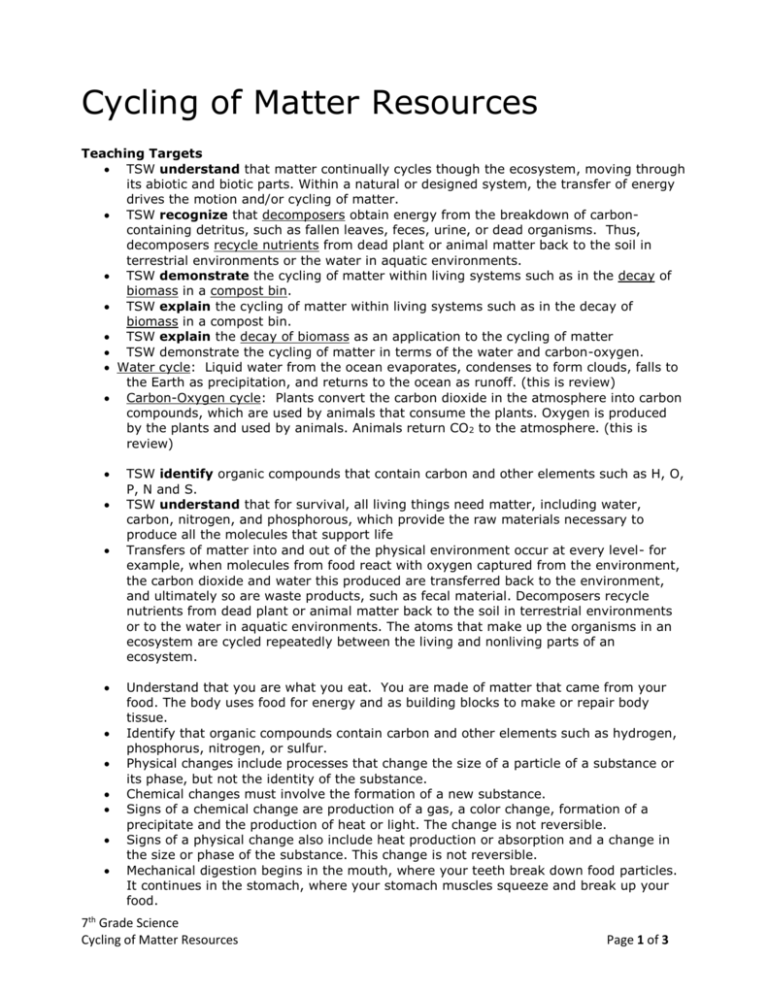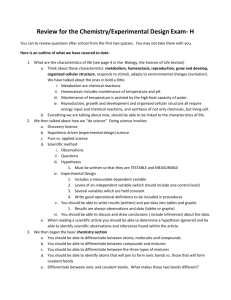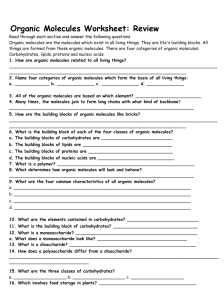What Students Need to Know about
advertisement

Cycling of Matter Resources Teaching Targets TSW understand that matter continually cycles though the ecosystem, moving through its abiotic and biotic parts. Within a natural or designed system, the transfer of energy drives the motion and/or cycling of matter. TSW recognize that decomposers obtain energy from the breakdown of carboncontaining detritus, such as fallen leaves, feces, urine, or dead organisms. Thus, decomposers recycle nutrients from dead plant or animal matter back to the soil in terrestrial environments or the water in aquatic environments. TSW demonstrate the cycling of matter within living systems such as in the decay of biomass in a compost bin. TSW explain the cycling of matter within living systems such as in the decay of biomass in a compost bin. TSW explain the decay of biomass as an application to the cycling of matter TSW demonstrate the cycling of matter in terms of the water and carbon-oxygen. Water cycle: Liquid water from the ocean evaporates, condenses to form clouds, falls to the Earth as precipitation, and returns to the ocean as runoff. (this is review) Carbon-Oxygen cycle: Plants convert the carbon dioxide in the atmosphere into carbon compounds, which are used by animals that consume the plants. Oxygen is produced by the plants and used by animals. Animals return CO2 to the atmosphere. (this is review) TSW identify organic compounds that contain carbon and other elements such as H, O, P, N and S. TSW understand that for survival, all living things need matter, including water, carbon, nitrogen, and phosphorous, which provide the raw materials necessary to produce all the molecules that support life Transfers of matter into and out of the physical environment occur at every level- for example, when molecules from food react with oxygen captured from the environment, the carbon dioxide and water this produced are transferred back to the environment, and ultimately so are waste products, such as fecal material. Decomposers recycle nutrients from dead plant or animal matter back to the soil in terrestrial environments or to the water in aquatic environments. The atoms that make up the organisms in an ecosystem are cycled repeatedly between the living and nonliving parts of an ecosystem. Understand that you are what you eat. You are made of matter that came from your food. The body uses food for energy and as building blocks to make or repair body tissue. Identify that organic compounds contain carbon and other elements such as hydrogen, phosphorus, nitrogen, or sulfur. Physical changes include processes that change the size of a particle of a substance or its phase, but not the identity of the substance. Chemical changes must involve the formation of a new substance. Signs of a chemical change are production of a gas, a color change, formation of a precipitate and the production of heat or light. The change is not reversible. Signs of a physical change also include heat production or absorption and a change in the size or phase of the substance. This change is not reversible. Mechanical digestion begins in the mouth, where your teeth break down food particles. It continues in the stomach, where your stomach muscles squeeze and break up your food. 7th Grade Science Cycling of Matter Resources Page 1 of 3 Chemical digestion of food also starts in the mouth then continues into the stomach and small intestines. This is where food is chemically broken down into essential nutrients keeping your body healthy and functioning normally. Chemical digestion changes food into fuel for your body. Mechanical digestion breaks down food particles so it is chemically digested faster. Both chemical digestion and mechanical digestion take place in the mouth and stomach. Large molecules are broken down during digestion. Large molecules are composed of chains of smaller units (such as sugars) like boxcars connected to make up a train. Elements of compounds are rearranged due to chemical changes (this enables the system to meet the needs of the system). Carbohydrates, fats (lipids), proteins, vitamins and minerals. Enzymes chemically break down large food molecules into smaller molecules that can be absorbed and used by the body. The student is expected to recognize how large molecules are broken down into smaller molecules such as carbohydrates can be broken down into sugars. A molecule is formed when two or more atoms join together. Molecules can consist of two or more atoms of the same element or from more than one type of element. Large molecules are made of chains of smaller units. Our bodies take larger molecules and break them down through chemical changes during digestion to create smaller molecules that can be absorbed by the body. Carbohydrate chains are broken into simple sugars. Protein chains are broken into amino acids. Lipid chains (fats) are broken into fatty acids. Supporting Resources Chew on This Lab – Student Pages (Laying the Foundation) Chew on This Lab – Teacher Pages Food web of Compost Pile Carbon Cycle – PowerPoint Carbon Cycle Worksheet Matter Cycles – Reading & Questions Organic vs Inorganic Sort Composting for Kids – Slide Show AstroBiology – The cycle of matter (teacher pages) AstroBiology – The cycle of matter (student handouts) http://www.neok12.com/Carbon-Cycle.htm Make a Decomposition Column Web Links – Cycling of Matter Cycling of matter - stations Energy Flow in Ecosystems Activity Composting Lab Science Activity: Feeding You Garden Composting in a Jar The Rotting World Testing for Carbohydrates Carbohydrates – Nutrition Information Organic compounds – Table and Questions What happens to a burger Organic Compounds - Powerpoint Comparing physical and chemical digestion 7th Grade Science Cycling of Matter Resources Page 2 of 3 Digestion of Carbohydrates Organic Compounds for Lunch Teacher Instructions Organic Compounds Student Lab Procedure and Data Table Student Handout Student Handout - KEY Content Reference Materials Composting Virtual Tour Composting – Slide Show Assessments Exit Ticket – Decay of Biomass 7th Grade Science Cycling of Matter Resources Page 3 of 3






